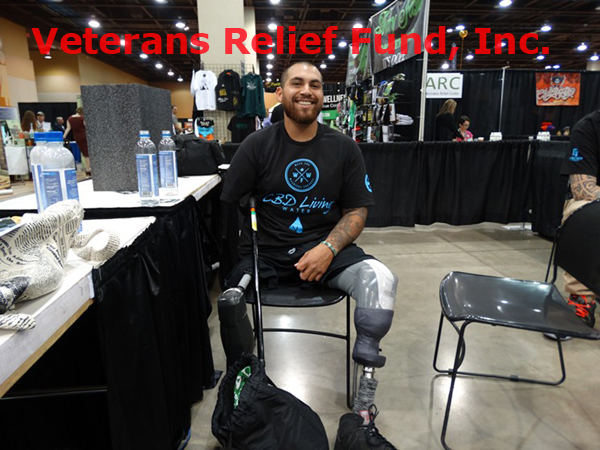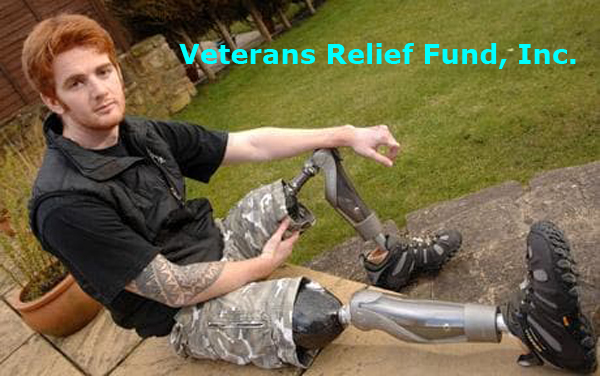
These prosthetics are an example of an IN KIND Donation
to The Veterans Relief Fund, Inc. 501C3 of California
Other examples of IN KIND Donations.

The charity should provide a written communication or
acknowledgement to the donor. For a nonprofit, it is a best practice
to send the donor a written acknowledgement that includes the name
and EIN of the charity, as well as the date received and a detailed
description of the in-kind contribution.
In order for a donor to claim a donation that exceeds $250 as a
charitable contribution on his/her federal income tax return, a
written acknowledgment must be in the donor’s possession and it
should include a statement about whether the donor received any
goods or services in exchange for the donation (and if so, the value
of the goods or services received).
In addition, for direct donations the nonprofit should also
provide a statement of the amount donated (i.e., the face value of
the check, stock or the cash received).
(example case)
12 Pounds of Marijuana saved the Smith's marijuana farm from a
tax lien sale. The gift to the nonprofit equaled a $13,000
cash receipt which was immediately applied to the taxes they owed.
The medicine supplied 192 vets with medical marijuana in October of
2017, at the VA hospital in Los Angeles, through a non profit called
the Veterans Relief Fund, Inc. a California 501(c)(3) charity
corporation. The donation was then credited towards taxes owed,
thus making it an IN KIND donation.
Contact:
veteransrelieffundinc@gmail.com
Provide Veterans with Relief through your IN - KIND
donations!
Can my donor take a tax deduction for in-kind
donations?
Your organization just found out it will receive a donation of new
laptops for the office. Do you know what type of information to
include in an acknowledgement? A board member just found out that
the parking and meals he has been paying for on the nonprofit’s time
may be deductible. What type of information should be on his tax
receipt?
Generally a donor may deduct an in-kind (or, non-cash) donation
as a charitable contribution. And a donor must obtain
a written acknowledgement from the charity to
substantiate the gift, although the acknowledgement will
generally not assign a dollar value to the donation.
Not only are the written acknowledgement requirements complex,
especially for non-cash donations, but noncompliance can be costly
(generally $10 per contribution).
In-kind donations generally fall into one of three
categories:
- Direct payment by a donor of bill owed by the
charity to a third party.
- Donations of goods.
- Donations of services.
But for in-kind donations, the responsibility is on the donor to
value the donation. Nevertheless, the nonprofit may also desire to
state something like “were it not for your donation, we would have
had to expend $________ to procure such an item.” This can be
helpful as a fundraising tool when making major donor lists, for
example.
Easiest for the donor and the charity to document and verify are
direct payments by a donor of an amount owed by the charity to a
third party, such as what was paid to the laptop vendor in our above
example. An organization should, of course, confirm with the vendor
that the invoice was paid (and not somehow discounted and then paid)
and receive written confirmation from the vendor. Once confirmed,
the charity may provide a written donor acknowledgement.
But donations of goods are more complicated. The charity must
still provide the written acknowledgement to the donor. The value of
the donation is up to the donor, as described above, and if believed
to be in excess of $5,000 in value is generally obtained from an IRS
qualified appraisal.
Personal services are not deductible, but the expenses associated
with providing these services are. For example, if a business owner
authorizes employees to use company time to provide services, then
payroll and associated costs are deductible. Further, if the
charity sells or transfers the goods within three years of
receiving, the charity must complete IRS Form 8282
(Donee Information Return) and file with the IRS.
Donations of services are more complicated still. Generally
personal services are not deductible, however, the expenses
associated with providing such services are. For example, if a
business owner authorizes employees to use company time to provide
services (such as an associate at a law firm), then payroll and
associated costs are deductible, in addition to expenses directly
related to the service. It is important for the donor to
keep detailed records, such as of the parking and meal expenses in
the opening example.
Again the nonprofit charity should provide a written
acknowledgement to the donor. This particular acknowledgement should
be substantially identical to the other acknowledgements, except
that it should not contain a dollar amount for the costs or
expenses. Instead it should provide a description of the services
and the year of the services.A
“charitable contribution” is tax deductible for a donor if it is
“to” or “for the use of” a charity.
IRS Publication
1771 (pdf) contains examples of appropriate written
acknowledgements for non-cash gifts.
A “charitable contribution” is tax deductible for a donor if it
is “to” or “for the use of” a charity. Staffers at charities who
provide donors with the appropriate written acknowledgements should
proceed with caution in acknowledging in-kind donations.




